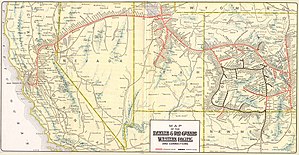Western Pacific Railroad
| File:Western Pacific Railroad logo, color.jpg | |
| Overview | |
|---|---|
| Headquarters | San Francisco, California |
| Reporting mark | WP |
| Locale | California, Nevada, and Utah |
| Dates of operation | 1903–1983 |
| Successor | Union Pacific |
The Western Pacific Railroad (reporting mark WP) was a Class I railroad in the United States. It is now part of the Union Pacific Railroad (UP). It was the second railroad company to use this name. The original Western Pacific Railroad (1862-1870) was established in 1865 to build the western-most portion of the Transcontinental Railroad between San Jose, California (later Oakland, California), and Sacramento, California. This company was absorbed into the Central Pacific Railroad in 1870.
History

Founded in 1903, the Western Pacific Railroad was built as a portion of the Gould family's efforts to create a transcontinental railroad in the late 19th and early 20th century.
One of the American West’s most popular railroads, the WP attracted rail enthusiasts from around the world. From 1910 to 1982, its diverse route provided scenic views of the San Francisco Bay Area, the mountain communities of the famous Feather River Route, and the deserts of Nevada and Utah. The Western Pacific originated in 1900 as the Alameda and San Joaquin Railroad. The railroad which would become the Western Pacific was financed and built by the Denver and Rio Grande Western Railroad, under the direction of George Jay Gould I, to provide a standard gauge track connection to the Pacific Coast. In 1909, it became the last railroad completed into California.
In 1931, WP opened a second mainline north from the Feather River Canyon to the Great Northern Railway in northern California. This route, called the "Highline", joined the Oakland - Salt Lake City mainline at a junction known as the Keddie Wye. Considered the heart of the railroad, this unique structure featured two steel trestles and a tunnel, all forming a triangle of intersecting track.
One of the more well-known aspects of the Western Pacific was its operation of the California Zephyr passenger train, in conjunction with the Denver and Rio Grande Western Railroad and the Chicago, Burlington and Quincy Railroad. The WP handled the "Silver Lady" from Oakland, California, to Salt Lake City, Utah from 1949-1970. The Western Pacific owned several connecting short-line railroads. The largest and most well-known was the Sacramento Northern Railway, which at one time reached from San Francisco to Chico, California. Others included the Tidewater Southern Railway, the Central California Traction, the Indian Valley Railroad and the Deep Creek Railroad.
The Western Pacific was acquired in 1983 by Union Pacific Corporation, which would eventually purchase its long-time rival, the Southern Pacific Railroad, in 1996. In July 2005, Union Pacific unveiled a brand new EMD SD70ACe locomotive, Union Pacific 1983, painted as an homage to the Western Pacific as part of a new heritage program.
Innovations and improvements
Since it competed directly with the long-entrenched and much larger Southern Pacific Railroad, the WP became a company known both for its innovation and for wringing every dollar out of an investment. It was the first large railroad in the West to eliminate steam locomotives in favor of diesels, then kept some of these early diesels running in regular service long after they had been retired elsewhere. WP also rebuilt many well worn diesels (30) by sending them to Salt Lake City rebuilder Morrison Knudson (M_K Rebuild). It embraced computerized dispatching, concrete railroad ties and innovative equipment to protect customer shipments. The WP purchased new cabooses in the 1960s to replace older wood type cabooses which they scrapped or sent to subsidiaries Sacramento Northern or Tidewater Southern. The WP also purchased new freight cars of the following: autoparts boxcars, covered hoppers, various types of single- and double-door boxcars, bulkhead flatcars, centerbeam flatcars, and also rebuilding outmoded freight cars (such as 40-foot open gondolas for chip-hauling and service). These freight cars were bought to meet its shippers' requirements. WP was one of the first to run solid trains of COFC (Container On Flat Car) traffic from Oakland APL American Presidents lines to points east via Union Pacific. WP had autoparts on special trains to Milpitas, CA (Ford Plant) with a connection from DRGW or UP at Salt Lake City. The WP yards were located in Stockton, Milpitas, Oroville, Portola, Elko, Oakland, Keddie, Winnemucca, and Salt Lake City.
Passenger Operations
While the California Zephyr was the Western Pacific's most famous and popular passenger train the railroad also operated a modest fleet of named trains. These include:
- Exposition Flyer (operated between Chicago and Oakland in conjunction with the Chicago, Burlington and Quincy Railroad and Denver and Rio Grande Western Railroad prior to the CZ and named after the Golden Gate International Exposition of 1939 and 1940)
- Feather River Express (between Oakland and Portola, California)
- Royal Gorge (between Oakland and St. Louis)
- Scenic Limited (between Oakland and St. Louis)
- Zephyrette (between Oakland and Salt Lake City)
Gallery
-
Western Pacific #3009, an EMD GP35, stops for servicing in Stockton, California in 1974.Template:Pufc
-
Western Pacific #805A, an EMD FP7 locomotive on display in June, 1999 at the Western Pacific Railroad Museum in Portola, California.
References
This article includes a list of references, related reading, or external links, but its sources remain unclear because it lacks inline citations. (October 2009) |
External links
- Western Pacific Railroad Museum in Portola California
- Western Pacific Railroad Historical Society
- Livermore History - Railroads 1
- WP Subsidiary Tidewater Southern Website
- WP Subsidiary Sacramento Northern Website
- WP Subsidiary Central California Traction Website
See also
- Western Pacific Railroad
- Predecessors of the Union Pacific Railroad
- Companies based in San Francisco, California
- Former Class I railroads in the United States
- Defunct California railroads
- Defunct Nevada railroads
- Defunct Utah railroads
- Railway companies established in 1916
- Railway companies disestablished in 1987
